Sanatan Articles
Satyaagrah
Written on
Satyaagrah
Written on
Satyaagrah
Written on
Satyaagrah
Written on
Satyaagrah
Written on
JOIN SATYAAGRAH SOCIAL MEDIA
"15 remarkable women who shaped India's Constitution": Traverse India's history with the pioneers who sculpted the constitution, forging a foundation of equality, unity, and immense pride, their tales are modern India's touchstones of courage

In the golden annals of India's history, a date gleams with extraordinary significance - the 26th of January, 1950. Seven decades have flown since that monumental day, a day that etched the ceaseless labour and dedication of 389 steadfast individuals into the robust framework of a fledgling nation, now standing tall and proud. A beacon of light in the darkness, the Constitution of India was brought to life, embodying the very essence of unity in diversity.
As the sun rose on that brisk winter morning 70 years ago, history was being forged in the grand Constitution Hall situated in the heart of New Delhi, on Rafi Marg. A congregation of the nation's towering political figures gathered, their hearts beating as one, fueled by a singular mission: to craft a Constitution that embraced every Indian citizen, transcending barriers of gender, caste, and class.
Amongst the formidable gathering, a group of 15 resilient women marked their presence, an undeniable testament to the shifting sands of time. While their representation might have seemed minimal, their influence was nothing short of paramount. Originating from various corners of the nation, from contrasting faiths and diverse socio-economic backgrounds, they were united by a shared vision - to foster a nation grounded in equality and mutual respect.
By 10:45 am, as the clock ticked steadily forward, the aura of anticipation and hope permeated the grand hall. Figures clad in overcoats and shawls filled the seats, their faces reflecting the gravity of the momentous occasion that was unfolding before them. A symphony of applause resounded within the hall as Sachchidananda Sinha, one of the most seasoned parliamentarians of the time, ascended to take the chair, inaugurating the first meeting of the Constituent Assembly.
With a fervor that reverberated through the walls, Sinha invoked the eloquent words of the renowned Urdu poet Iqbal, urging all to embark on this noble journey guided by the principles of "wisdom, toleration, justice, and fairness to all." As his stirring words echoed, a transformative energy enveloped the assembly. One by one, they aligned in solemn rows, their signatures on the register marking the beginning of a new chapter, one filled with promise and the spirit of togetherness.
Amidst the esteemed assembly, the contribution of the 15 women stood as a beacon of hope, illuminating the paths of countless others who would follow in their footsteps. Their diverse histories were not just mere stories, but powerful narratives that mirrored the rich and varied tapestry of women's leadership and activities in the era before independence. Their voices resounded with a potent message, advocating for freedoms in myriad forms, championing non-discrimination, and nurturing the core principles that would underline the Constitution.
Meera Velayudhan, a luminary in the realm of women's studies and the proud daughter of Dakshayani Velayudhan, recollected the groundbreaking journey of these women with reverence. She remarked, “What was striking about the women are their diverse histories, which point to the rich history and trajectories of women’s leadership and activities in pre-independence era… their interventions were about varied freedoms, non-discrimination, equality, liberty, core principles underlying the Constitution and about citizenship in a new nation.”
As we delve deeper into the untold saga of India's constitution formation, it becomes imperative to illuminate the less sung heroes who etched their indelible marks on the parchment of history. In an era largely governed by patriarchal norms, the reverberations of the impactful roles played by several visionary women should echo across generations.
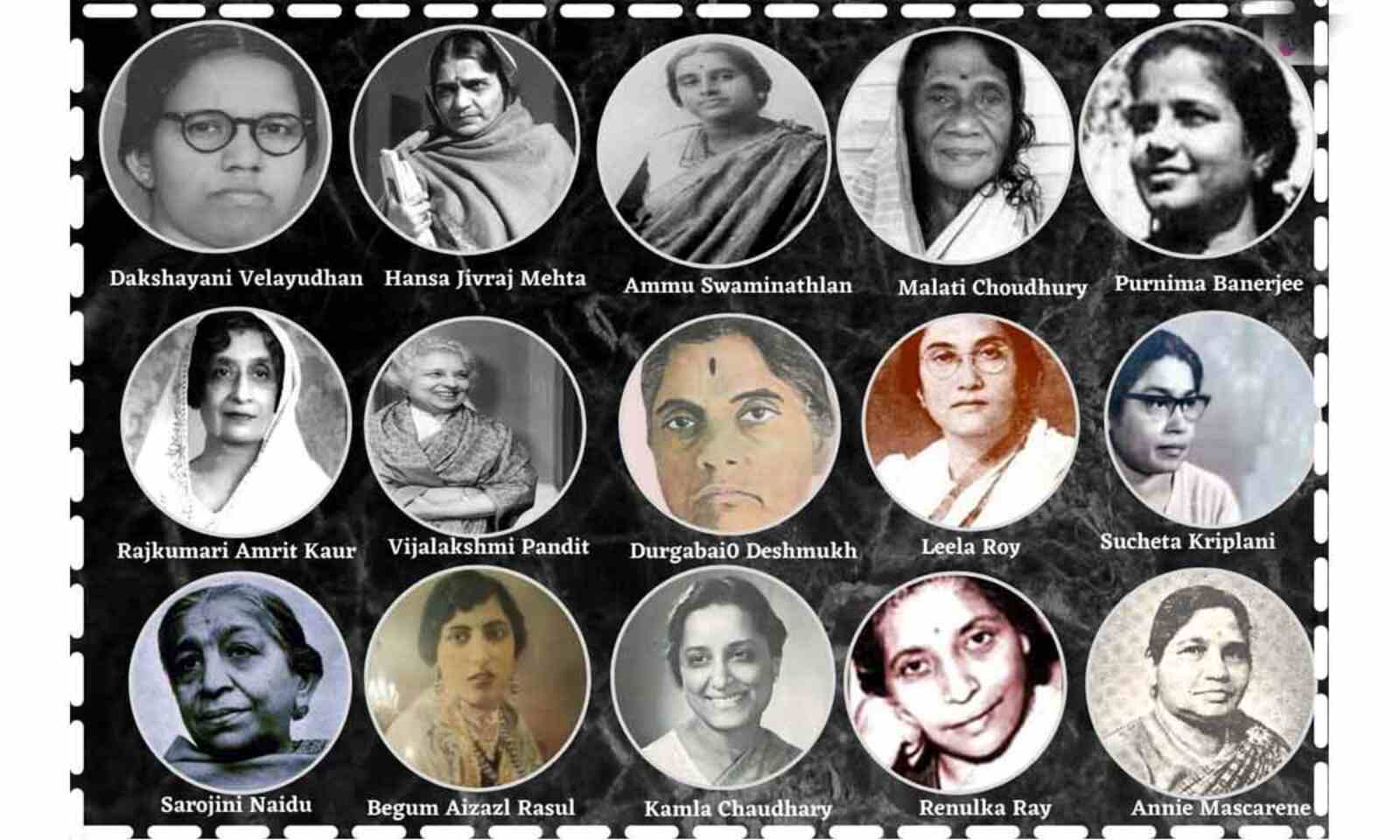 |
While history paints a vivid picture of the male congregants of the Constituent Assembly, we often visualize a potent picture: Dr. B. R. Ambedkar, fervently articulating his revolutionary ideas, his glasses catching the glint of the chandeliers; Nehru, his signature topi slightly askew, emphasizing fervently on the sanctity of a ‘secular’ nation; and Vallabhbhai Patel, the epitome of stoicism, offering measures grounded in conservatism. These images are indeed revered, but they represent only half the canvas.
Beyond the limelight, in the nuanced details of the historical tapestry, names such as Begum Aizaz Rasul, Durgabhai Deshmukh, Renuka Ray, Purnima Banerjee, and several others shimmer with an untold glory, waiting to be celebrated. These formidable women emerged as visionaries and trailblazers in a land that was slowly unshackling itself from the chains of colonization, and where the 'weaker sex' found little favor.
Despite facing the dual challenges of a society in transition and deeply ingrained patriarchy, these resilient women brought forth an enlightened perspective, advocating for a Constitution that embodied openness, fairness, and accessibility to all. They were not merely contributors; they were the harbingers of an India that aspired to be a sovereign, socialist, secular, and democratic nation, where every citizen stood equal.
|
Ammu Swaminathan
Among these luminaries was the stalwart Ammu Swaminathan, a beacon of hope and empowerment. Born into an upper-caste Hindu family in the picturesque landscapes of Kerala, Swaminathan emerged as a fervent social reformist and educator, embodying the spirit of equality and justice for every Indian citizen. Her journey from being an activist to a champion of women's rights is nothing short of an epic saga of determination and courage.
In 1917, Swaminathan embarked on a revolutionary journey, founding the Women's India Association in Madras. Alongside notable personalities such as Annie Besant, Margaret Cousins, Malathi Patwardhan, Mrs. Dadabhoy, and Mrs. Ambujammal, she ignited a flame that would engulf the nation in a fervor for equality and justice.
Swaminathan, affectionately known as ‘Ammukutty’, etched her legacy as a formidable force in the Quit India Movement, drawing inspiration and guidance from the venerable Gandhi. Her journey didn't halt there. As a member of the Constituent Assembly, her contributions to drafting the Indian Constitution were profound and far-reaching. In 1952, her remarkable journey saw her elected as a member of the Rajya Sabha representing the Madras constituency.
In a speech that resounded with power and conviction, she articulated the essence of the new India they were striving to build, proclaiming:
“Equal right is a great thing and it is only fitting that it has been included in the Constitution. People outside have been saying that India did not give equal rights to her women. Now we can say that when the Indian people themselves framed their Constitution they have given rights to women equal with every other citizen of the country.”
 Begum Qudsia Aijaz Rasul |
Begum Aizaz Rasul
Born into a princely family on 4 April 1908 in Punjab, politics and public life was not new to Begum Aizaz Rasul. She was involved in politics at a very young age- she attended political conferences with her father and also served as his secretary.
Rasul defied many traditional norms like the purdah system.
Rasul stepped into electoral politics in 1937 when she was elected as a member of the U.P. Legislative Assembly. She continued to be a member of the U.P. Assembly until 1951. Rasul was among the very few women legislators to be elected from a non-reserved province in British India- a remarkable achievement.
During her tenure as a member of the U.P. Assembly, she served in important posts like the Leader of the Opposition (1950-1952) and Deputy President of the Council (1937-1940).
She was a strong opponent of reservation for minorities in legislative assemblies, the partition of India, and feudal practices like the Zamindari system.
Rasul was the only Muslim woman in the Constituent Assembly. She representedthe United Provinces as a Muslim League member. In the Assembly, she intervened in the debates on national language, India remaining a part of the Commonwealth, reservation, property rights, and minority rights.
Rasul had an active political career post-independence as well. Rasul waselected to the Rajya Sabha (1952-1956). She was subsequently elected to the legislative assembly of Uttar Pradesh (1969 -1989).
Her views on reservations seemed to have changed. When invited to a convention to discuss the need for a reservation for Muslims in legislatures and services, Rasulsent a message –“As communal feelings have grown and the concept of Hindutva has gained popularity, it is time now to think anew of how to improve the educational and socio-economic conditions of Muslims.”
Rasul was deeply involved in popularising Hockey for Indian women. For two decades, she servedas the President of the Indian Women’s Hockey Federation. Later, she went on to head the Asian Women’s Hockey Federation.
She passed away in December 2001.
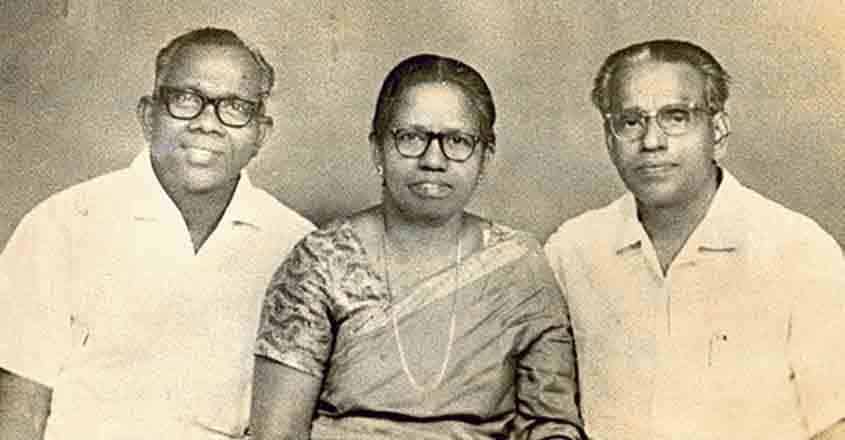 Dakshayani Velayudhan |
Dakshayani Velayudhan
Dakshayani Velayudhan wasbornon 15 July 1912 in Mulavukad a small island in the present-day Ernakulam district. She belonged to the Pulaya community, which was assigned to the rear end of the rigorously oppressive caste system. Pulayas were mostly engaged as lowly-paid agricultural labourers, and subjected to a range of humiliations including being barred from using public roads, maintaining a certain distance from upper caste persons, and the women prohibited from covering their upper bodies with any garment.
An important event was held in Kochi in 1913, in the form of theKayal Sammelanam. Hundreds of Pulayas, including Velayudhan’s family members, came together and met on small boats in Kerala’s backwaters, as they were barred from assembling on land. The event clearly had a significant impact on Dakshayani’s life, who is said to haverequestedthat her biography be titled ‘The Sea has no Caste.’
Velayudhan was inspired to enter active politics by her family members’ activeinvolvementin civil disobedience movements against upper-caste diktats.
Velayudhan emerged as a fierce critic of Congress politics,writing stronglyagainst them in the All India Scheduled Castes Federation’s (AISCF) weekly journal, Jai Bheem. At the same time, she was also critical of the AISCF and B.R. Ambedkar’s politics, specifically their demand for separate electorates for the Scheduled Castes.
Fierce often sexist attacks, from both Congress and AISCF followed. Fervent petitions were addressed to the Congress high command by opposing her nomination to the Constituent Assembly. In spite of these she was elected to the body in 1946.
In 1945, she had also beennominatedto the Cochin Legislative Council.
Velayudhan was elected to the Constituent Assembly from the Madras constituency. At the age of 34, she was one of the youngest and the only Dalit woman member of the Constituent Assembly.
In the Assembly, Velayudhan emerged as a strong, independent voice, unafraid to go against popular opinion. Velayudhan made her inaugural intervention during the Assembly’s response toNehru’sObjective Resolution. Asserting that although there were several models to follow when framing a constitution, sheemphasizedthat the Indian Constitution had a more substantial task than simply mediating the relationship between state and society; it had to overhaul society itself.
Velayudhan also took on B.R Ambedkar and M Nagappa on an amendment that would have required a reserved seat candidate to secure a minimum proportion of votes from Scheduled Caste voters, arguing that this was akin to separate electorates.
Velayudhan held strong views on the type of federalism that India should adopt. Her critique of the Draft Constitution of India 1948 focused on the lack of decentralization and the potential for a strong central government to dominate over state governments. She specificallyhighlightedthe method of appointing Governors of states, which she argued would further centralize power.
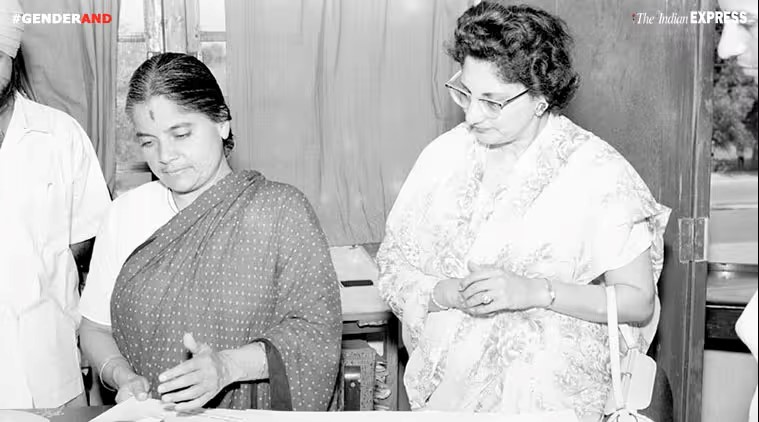 GammididalaDurgabai Deshmukh |
Durgabai Deshmukh
G. Durgabaiwas bornon 15th July 1909, in Rajahmundri, Kakinada. She was involved in the Indian freedom movement from a very young age: at 12, she quit school to protest the imposition of English as the medium of education. At the age of 14, she volunteered at a conference held by theIndian National Congressin Kakinada.
In May 1930, she participated in theSalt Satyagrahain Madras and was imprisoned in 1930 and 1932. In prison, she studied English and completed her M.A. fromAndhra University. She went on to study law fromMadras Universityand practised at theMadras Barfor a few years.
In 1936, she established Andhra Mahila Sabha to coach young Telugu girls in Madras for their Matriculation examination conducted by theBanaras Hindu University. Durgabai founded and edited a Telugu journal called Andhra Mahila.
Durgabai was elected to the Constituent Assembly from the Madras Province. She made several key interventions on issues that include the national language, judicial independence, and human trafficking.
After Independence, she was a part of key national organizations like theCentral Social Welfare Board, and the National Council for Women’s Education. She was also a member of thePlanning Commission. In 1958, she headed the National Committee on Girls’ and Women’s Education.
Durgabai was awarded the Nehru Literary Award in 1971 for her contribution to the promotion of literacy in India. She was awarded the Padma Vibhushan in 1975. The Central Social Welfare Board instituted a yearly award in her name to recognize voluntary organizations for outstanding contributions to women’s welfare and empowerment.
|
Leela Roy
Describedas a woman of indomitable spirit, Leela Roywasborn on 2 October 1900 at Goalpara, Assam. She completed her schooling at Eden High School in Dhaka. Subsequently her academic excellence earned her a scholarship for completing a B.A. in English at Bethune College, Calcutta where she was a recipient of a gold medal. She then graduated with a Master’s degree from the University of Dhaka becoming the University’sfirst female graduate.Roy’s achievementpromptedthe University to set up special evening classes for women.
A staunchfeminist,she encouraged and promoted women’s participation in social and political movements including the Indian freedom movement. Roy worked towards establishing educational institutions for women. Shefounded‘Deepali Sangha’ in 1923, an organisation that educated and trained women on social and political issues, leadership skills and physical fitness.
Shecriticisedleaders such as Mahatma Gandhi for propagating a limited role for women in public life- restricted to managing domestic responsibilities. She wanted women’s role in the freedom movement to go beyond just the picketing of liquor and other shops, and weaving khadi.
To further encourage women’s participation in public life, in 1931 Roy established ‘Jayashree’ a magazine that functioned as a forum for discussions and debates around nationalism and social issues.
Roy seemed to have engaged with both the revolutionary and moderate stands of India’s political landscape. In 1926, shejoinedthe ‘Shree Sangha‘, a revolutionary organisation led by Hemchandra Ghosh and Anil Roy, The Shree Sanghaoperatedprimarily in Dhaka- it mobilized youth groups and engaged in community service work. The Indian National Congress appeared to have acknowledged Roy’s contributions and in 1928invitedher as a delegate to the Congress Session at Calcutta. At this Session, shepresenteda paper on the History of the Women’s movement in Bengal.
Inspired by Subhas Chandra Bose, Roy also became a member of the central executive body of theForward Bloc– an organisation founded by Bose. Adding another role to her illustrious political career, she took on aneditorial positionin the ‘Forward Bloc Weekly’.
Shewaselected to the Constituent Assembly from Bengal on 9 December 1946. However, she resigned a few months later in protest against the partition of India.
Roy continued contributing to many social and political causes after she resigned from the Constituent Assembly.
In 1946, Roy helped thevictimsof the tragic Kolkata riots and built the National Service Institute for Rescue and Relief Work at Noakhali. She worked ardently for the rights ofrefugees.
Roy’s prolific political career continued into independent India. She became the Chairwoman of the party formed by merging the Forward Bloc and the Praja Socialist Party in 1960. She retired from active politics in 1962.
Kamla Chaudhri
Kamla Chaudhriwasborn on 22 February 1908 in Lucknow. Shecompletedthe Ratna and Prabhakar examinations in Hindi literature despite objections from her family. Chaudhri produced a range of literary work mostly focussed on the lived experience of Indian women.
She was an active member of the Indian National Congress and an Elected Member of the Provincial Congress Committee and the Provincial Mahila Congress Committee.
Kamla Chaudhri actively worked towards educating girls in villages and backward areas. She encouraged the Khadi and Village industries which she felt had the potential provide employment of young women.
Chaudhri participated in the Civil Disobedience Movement (1930) and was arrested on several occasions.
Shewaselected to the Constituent Assembly from the United Provinces (now Uttar Pradesh) in 1946.
Shewasa Member of the Provisional Parliament (1947 to 1952) and acted as the Senior Vice-Chair of the 54th Indian National Congress Session. She entered the Lok Sabha in 1962 after winning from Hapur District in Uttar Pradesh.
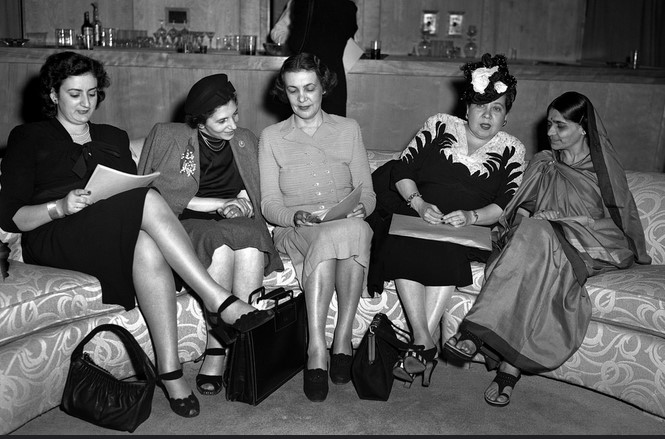 Extreme right: Hansa Mehta/Flickr/UN |
Hansa Jivraj Mehta
Hansa Jivraj Mehta was born on 3rd July 1897 in Surat, Gujarat. She studied philosophy at Baroda College and then journalism and sociology in England. In 1920, while in London, Mehta met Sarojini Naidu who would later introduce her to Mahatma Gandhi and the Indian women’s freedom movement.
Mehta’s political career was marked by her 1937 Bombay Legislative Council election win. Having refused to contest from a reserved seat, she took on the elections as a general category candidate. Mehta remained on the council until 1949.
During this time, Mehta became closely involved with the All India Women’s Conference and became its president in 1946. During her presidency, she drafted the Indian Women’s Charter of Rights and Duties, which demanded gender equality and civil rights for women.
At the same time, in 1946, Mehta served as a member of the United Nations sub-committee on the status of women. She was the vice-chair with Eleanor Roosevelt of the United Nations Universal Declaration of Human Rights Committee. Further, she became the first female Vice-Chancellor in India with her appointment at SNDT University in Bombay.
Mehta participated in the non-cooperation and swadeshi movements. Her involvement with India’s freedom struggle got her arrested in 1932.
Mehta was one of the 15 women framers of the Indian Constitution. She was elected to the Constituent Assembly from Bombay under a Congress Party ticket. In the Assembly, she strongly argued in favour of women’s rights and intervened in debates on uniform civil code and reservation.
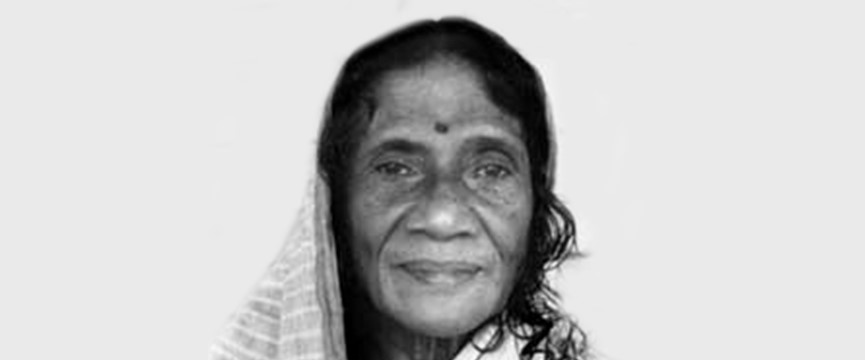 Malati Devi Choudhury |
Malati Choudhury
Malati Chaudhary wasbornon 26 July 1904, in Calcutta to a family of politicians. At the age of 16, Chaudhary refused to join college and complete her education. Instead, in 1921, she was joined Visva Bharti in Shantiniketan. It was here that her views on patriotism and the freedom movement developed. They were also deeply influenced by Tagore. Choudhary moved to Orissa in 1927 and engaged in grassroots works for underprivileged communities. Chaudhary was a Marxist, woman freedom fighter who actively participated in the diverse struggles of oppressed communities in Orissa. She was fondly called Numa by those she inspired.
Chaudhary played a vitalrolein India’s Independence Movement. She was arrested and imprisoned several times (1921, 1930, 1936, 1942) by the British, for her participation in various freedom movement activities.
In 1933, Choudhary started actively participating in the Congress party. Along with her husband, she organised the Utkal Congress Samajvadi Karmi Sangh, the Orissa branch of the All India Congress Socialist Party. Choudharyfoundedthe Post Basic School at Champatimunda, Orissa. In 1946, she set up the Bajiraut Chhatravas to educate the children of freedom fighters and became the president of the Orissa Pradesh Congress Committee. She had a significant impact on freedom struggle movements organised on the local levels.
In 1934, Malati took part in M.K. Gandhi’s padayatra in Orissa. She led the Krisaka Andolan to save farmers from exploitation by landowners and moneylenders. She played a central role in the peasants uprising in Orissa in the 1930s and established the Utkal Provisional Kisan Sabha that worked towards the abolition of the zamindari system.
She was elected to the Constituent Assembly from Orissa through a Congress ticket. However, she resigned from the Assembly that very year to work with Gandhi and because she felt ‘unfit’ for the work. She wanted to continue working on the ground with farmers, Dalits, tribals, and children.
Purnima Banerjee
Purnima Banerji was involved in the freedom struggle along with Sucheta Kripalani, Vijaylakshmi Pandit, and Uma Nehru. She took part in the individual Satyagraha and Quit India movements.
She was amemberof the Congress Socialist Party and the Indian National Congress. As a Secretary of the Allahabad City Congress Committee, Banerji worked towards creating rural engagement. She also conducted meetings with kisans and trade unions.
Banerji was appointed to the Constituent Assembly from the United Provinces. In the Assembly, she intervened in discussions around the Preamble, preventive detention and qualifications of Rajya Sabha members.
Rajkumari Amrit Kaur
Rajkumari Amrit Kaur wasbornon 2 February 1889 in Lucknow into Punjab’s Kapurthala Royal family. Her father, Raja Harnam Singh, hadconvertedto Christianity as a young boy and subsequently, kept himself out of the line of successors to the throne. In Lucknow, Kaur, the only daughter among 7 children grew up with her siblings on Christian teachings. After an initial period of home-schooling, she was sent to Sherborne School in Dorsetshire, England to complete her school education. She continued her stay in England, graduating with a remarkable academic and extra-curricular record from the University of Oxford.
Once she completed her education, Kaur returned to India aged 20. By 1919, Kaur had begun to grow closer to Gandhi and his teachings. Though she held a deep will to join his ashram, she was initiallydeniedpermission by Gandhi as he felt she was still attached to her material life and that her parents were not too inclined to join the Ashram. So, in the initial years after her return, Kaurcommittedmost of her energy to social causes concerning women such as abolishing the practice of purdah, child marriage, and the Devadasi tradition. By 1927 she had co-founded theAll-India Woman’s Conference, serving as its secretary in 1930 and president in 1933. Finally, in 1934 she was able to join Gandhi’sSewagram Ashram, where she remained his secretary for sixteen years.
Kaur developed her inclination to politics during the time she spent with her father, who had close associations with many Congress party veterans such as Gopal Krishna Gokhale. By the 1930s Kaur had ventured into the Indian freedom struggle. She strongly criticized Ramsay MacDonald’s 1932 communal award which presented separate electorates to several minority communities and oppressed castes. At the 1932 All-India Women’s Conference, she moved a resolution to register their opposition to the award for ‘touching the womanhood of India’ and to unitedly push for joint electorates.
For her participation in various Indian freedom movements, Kaur was imprisoned by the British on multiple occasions. During the Salt Satyagraha, she was arrested for her involvement from Bombay. In 1937, she went to jail again – this time on charges of sedition. Kaur returned to jail in 1942 for taking part in the Quit India movement. The brutal lathi charge she went through during the process took a toll on her health. Eventually, she was brought out of jail and put on house arrest in Shimla.
Through most of her life, Kaur remained a staunch Gandhian, espousing Gandhian values such as the wearing of Khadi and leading a simple life within Sewagram Ashram.
She waselectedto the Constituent Assembly from the Central Provinces and Berar province on a Congress ticket. Though Kaur did not speak much during the Constituent Assembly proceedings, she was a member of importantsub-committeesin the Assembly and was instrumental in shaping many constitutional provisions.
She was a prominent member of the Assembly’s Fundamental Rights Sub-Committee and the Minorities Sub-Committee. Within the sub-committee, she expressed her opposition to the inclusion of freedom to practice religion as this could give constitutional protection to various discriminatory practices such as purdah, sati, devadasi system etc. Her protest was effective as the condition that freedom to practice would not restrict the State from making laws for social reform eventually found its way into the Constitution. Kaur also voted in favour of the State framing a Uniform Civil Code. Though the provision was voted out, it was included in the non-justiciable Directive Principles of the State Policy.
In 1947 shebecameindependent India’s first Health Minister when she joined Prime MinisterJawaharlal Nehru’sinterim cabinet and served in that capacity for ten years. She was also the first woman member of the post-independence cabinet. In 1956 she introduced the AIIMS Bill in Parliament, making way for the establishment of theAll-India Institute of Medical Sciences (AIIMS)to raise the level of medical education within the country. She was also a strong advocate of the nursing profession, pushing for the setting up of many nursing training centres.
Education and health remained the main focus of her work for the next several years. She was the Deputy Leader of the Indian delegation toUNESCOin 1945 and 1946. In 1950, she became the first female and first Asian president of the World Health Assembly, and also led India’s delegation to theWorld Health Organizationseveral times between 1948 and 1953. She was also a founder-member and Chairperson of theIndian Red Cross Societyand in 1957 was honoured by the League of Red Cross Societies with the Court Bernadotte Gold Medal for her long and dedicated service in the field. She later became the vice-president of the Internation Red Cross Society. She also held the post of President at the Indian Leprosy Association and the Tuberculosis Association.
She firmly believed in the idea of free education for all, particularly working for the cause of women’s education. She was among the Board of Trustees of the Nankana Sahib Education Trust and the Hindustani Talimi Sangh. She was one of the founding members of Delhi’sLady Irwin College. Her work towards welfare of children led to the founding of theIndian Council of Child Welfare, serving as its first President from 1948 to 1958. In 1956 Princeton Universityconferredher with an honorary Doctor of Laws degree.
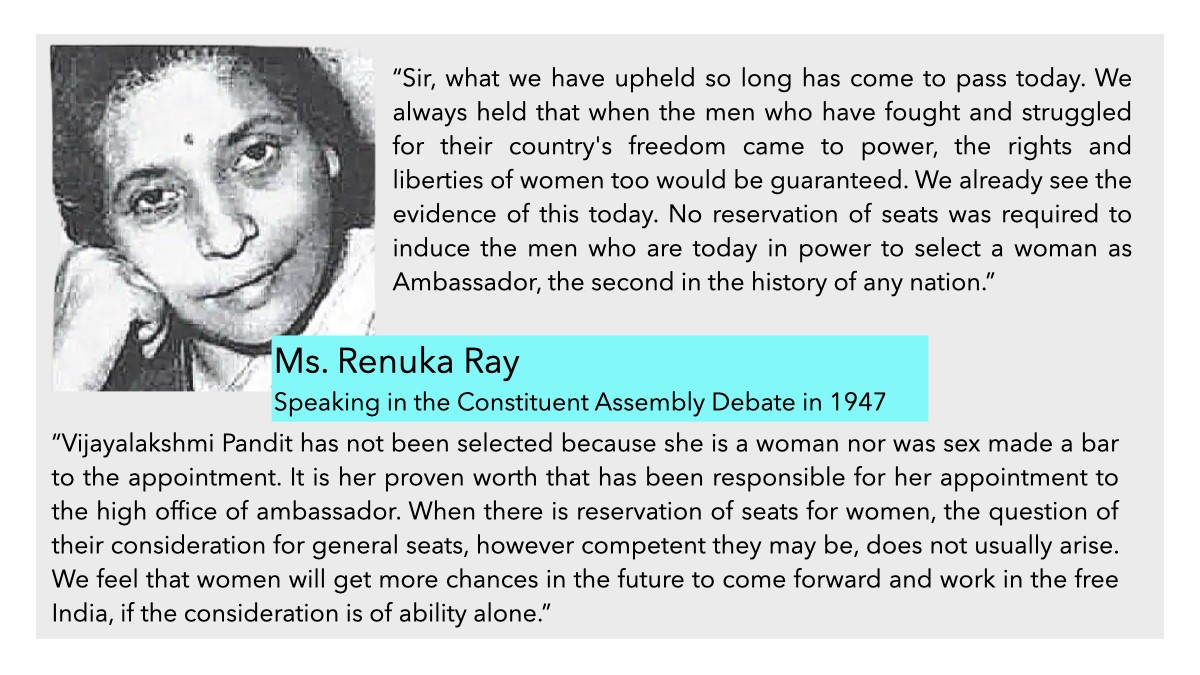 Renuka Ray |
Renuka Ray
The chapter of this historical exploration culminates with the remarkable Renuka Ray, a legal luminary and social worker who took significant strides in the pursuit of justice and equality for women. As the president of the All India Women's Conference in 1952, she championed the cause of a unified personal law code, fostering an environment of fairness and equality in the legal landscape of India.
Bornon 4th January 1903, Renuka Ray went on to receive education from Loreto House School and Diocesan College, Calcutta. Raykeenlyfollowed the Indian political developments from a young age. Persuaded by Gandhi’s call for fight against British rule, she joined Gandhi’s ashram and accompanied him in protests. Later, she went on to obtain a degree from the London School of Economics.
Ray was a prominent women’s rights advocate. She was a legal secretary to the All India Women’s Conference and authored “Legal Disabilities of Women in India; A Plea for a Commission of Enquiry”. Shecloselyworked on the prevention of women trafficking and the improvement of conditions for women labourers.
Ray waselectedto the Constituent Assembly from West Bengal. She made several interventions in the Assembly including on women’s rights issues, minorities' rights, and bicameral legislature provision. RayrepresentedIndia in the U.N. General Assembly in May 1949. She was also elected to the West Bengal Legislature in 1952 and the Parliament in 1957. Ray wasawardedPadma Bhushan for her services in public affairs in 1988.
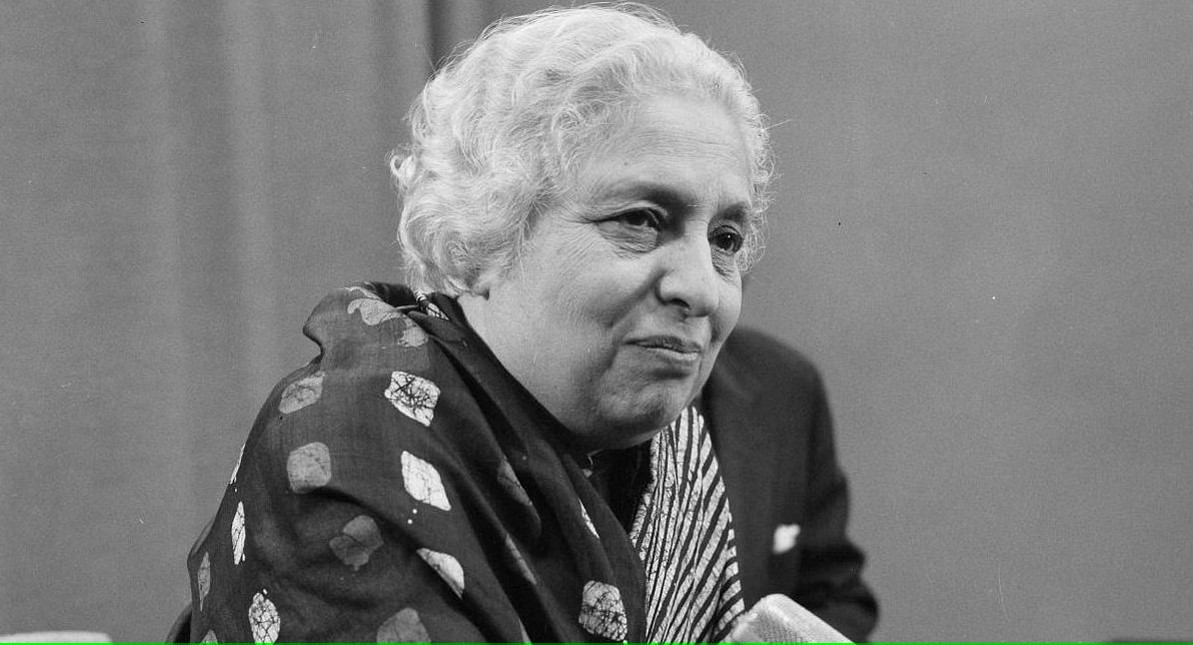 Vijaya Lakshmi Pandit |
Vijayalakshmi Pandit
Then was Vijayalakshmi Pandit, a name that resonates with grace, wisdom, and a fervent spirit of nationalism. Though often in the towering shadow of her illustrious brother, Jawaharlal Nehru, Pandit carved out a distinct and significant niche in Indian history. As an assembly member of the United Provinces in 1936 and later as the first Indian woman cabinet minister, she held the portfolios of local self-government and public health, pioneering a trajectory of empowerment and visionary governance.
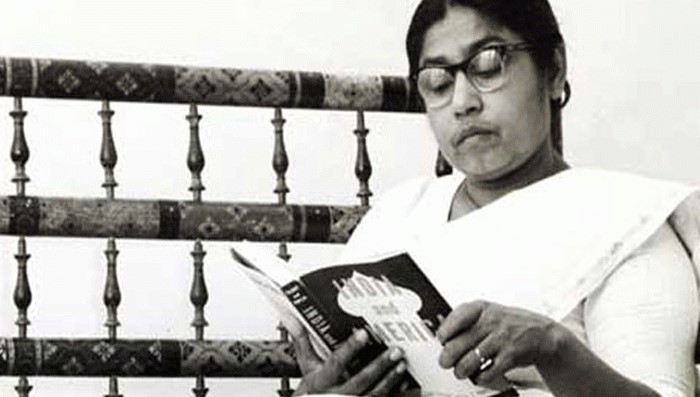 Sucheta Kriplani |
Sucheta Kriplani
Sucheta Kripalani was an Indian politician and freedom fighter born in the Ambala district of Haryana. She was the daughter of Surendranath Majumdar, a government doctor who was also a zealous patriot who had dedicated his life to the service of the nation. This patriotic fervour was instilled in Sucheta as well. She received her undergraduate education at Indraprastha College in New Delhi and completed her Masters at St. Stephen's College. She later became a Constitutional History lecturer at Banaras Hindu University (BHU). In 1936, Sucheta married J B Kripalani, a prominent member of the Indian National Congress.
In the words of Mahatma Gandhi, Sucheta Kripalani was “a person of rare courage and character who brought credit to Indian womanhood.” She is also remembered for her role in the 1942 Quit India Movement, where she made a significant contribution alongside other well-known women leaders of the time: Aruna Asaf Ali, Matangini Hazra, and Usha Mehta, among others. Sucheta Kripalani had a long and illustrious career in Indian politics. She was among the very few women elected to the Constituent Assembly of India. Kripalani represented the Kanpur constituency and was a member of the sub-committee that drafted the Indian Constitution. Sucheta was also a founding member of the All India Mahila Congress, founded in 1940.
In 1963, she became the first woman to hold the office of Chief Minister of Uttar Pradesh. Kripalani, an Indian politician who carved out her distinct path in Indian politics, passed away in New Delhi in 1974.
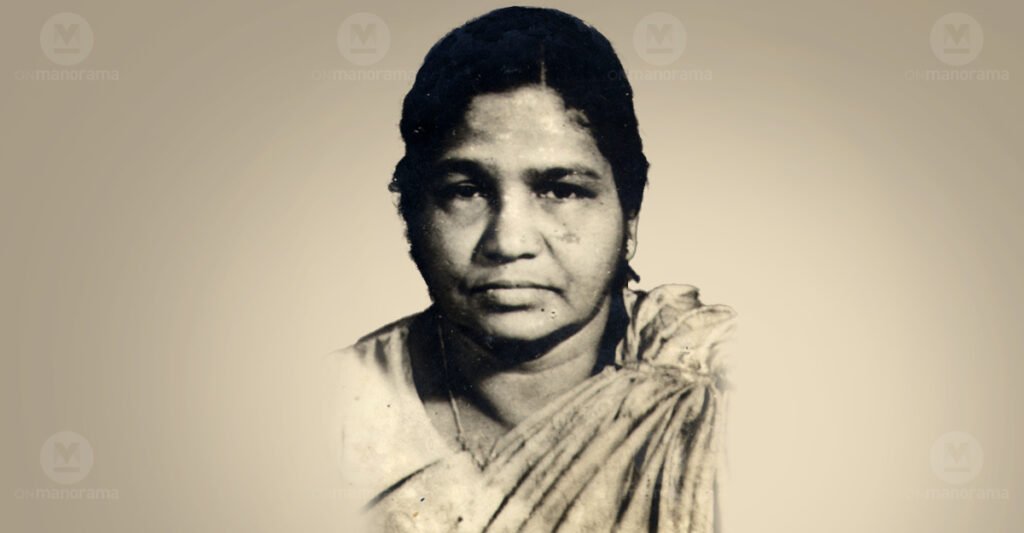 Annie Mascarene |
Annie Mascarene
In the serene landscapes of Travancore, a firebrand leader emerged - Annie Mascarene. A stalwart in the struggle for independence, she was a pivotal figure in the Travancore State Congress, marking a series of firsts as a member of the working committee and later as the first female parliamentarian from Kerala.
Annie Mascarene was born on 6th June 1902 at Trivandrum. She obtained a double M.A. in history and economics from Colleges for Arts and Law, Trivandrum, and went on to become a lecturer in Sri Lanka. After her return to Trivandrum, she procured a law degree.
She was a member of the Travancore-Cochin Legislative Assembly between 1948 and 1952 where she served briefly as a Minister in charge of Health and Power.
Mascarene representedthe Princely State of Travancore and Cochin Union in the Constituent Assembly. In the Assembly, she spoke on the issue of federalism.
Mascarene was elected to the first Lok Sabha as an independent candidate. She was the first woman from Kerala to have been elected to the Lok Sabha where she raisedconcerns about the under-representation of women in politics. Her political career took a hitafter her unsuccessful attempt in the 1957 Lok Sabha elections.
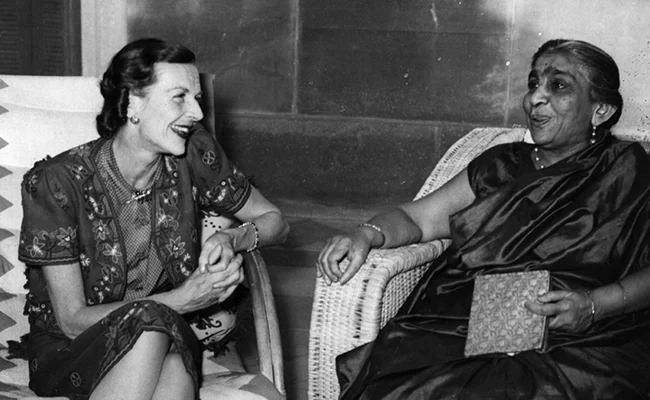 Sarojini Naidu |
Sarojini Naidu
Our journey culminates with the poetic and passionate Sarojini Naidu, the 'Nightingale of India'. As a prolific author, a dauntless freedom fighter, and a fervent activist, Naidu transcended boundaries, advocating fervently for India's independence on global platforms. A fierce advocate for women's rights, her studies on women's suffrage in England empowered her fight for the enfranchisement of Indian women. As the Constitution of India unfurled, it bore the stamp of her relentless efforts, ensuring universal suffrage and granting Indian women the right to vote.
Sarojini Naidu wasbornon February 13th, 1879 as Sarojini Chattopadhyaya in Hyderabad. Aghorenath Chattopadhyaya, her father, was a Principal of Nizam College and advocated for social reform and education for women. Naidu’s mother,Varada Sundari, was a Bengali writer and dancer. Naidu was educated at home; her father gave her lessons in Mathematics and Science and encouraged her to pursue them.
Shepassedthe Madras University matriculation exam at the age of twelve and obtained Hyderabad Nizam’s scholarship to study in King’s College, London, and later in Girton College, Cambridge. After her return to India, Naidu embarked on India’s freedom movement. She took part in the Congress session in Bombay in 1904. Thereafter, she madeassociationswith Gokhale, Tagore, Annie Besant, Gandhi, and Nehru. She went on tobecomethe first Indian women to preside Indian National Congress in 1925 at its 40th session, Kanpur.
Naidu wasinvolvedin the Non-cooperation movement, the Home Rule movement, and Salt Satyagraha. She wasarrested5 times during the freedom struggle. As a suffragette and women rights activist, sheadvocatedfor reforms to improve the conditions of widows in the Indian National Social Conference in Madras, in 1908. In 1917 sheheadedthe All-India Women’s Deputation and championed women’s suffrage before E. S. Montagu (Secretary of State for India). In the same year, she along with Annie Besant and othersset upthe Women’s India Association.
Naidu was appointed to the Constituent Assembly fromBihar. She spoke about the importance of adopting a national flag in the Assembly. Naidu wasappointedas the Governor of Uttar Pradesh from 15th August 1947. She held this office until her death on 2nd March 1949.
As we close this chapter, it is with a deep sense of reverence and gratitude that we reflect upon the lives of these remarkable women. In the corridors of time, their legacies echo, woven intricately into the fabric of a nation that rose phoenix-like from the ashes of colonial rule. Their fearless strides, their visionary outlook, and their indomitable spirit continue to inspire generations, painting a vibrant tapestry of a nation unified in its diversity, resilient in its character, and promising in its journey forward.
Their stories are not just tales of the past but a beckoning light, guiding us towards a future that echoes with the harmonious symphony of equality, justice, and fraternity - a melody that resonates with the dreams and aspirations of a sovereign, socialist, secular, and democratic India.
 Support Us
Support Us
Satyagraha was born from the heart of our land, with an undying aim to unveil the true essence of Bharat. It seeks to illuminate the hidden tales of our valiant freedom fighters and the rich chronicles that haven't yet sung their complete melody in the mainstream.
While platforms like NDTV and 'The Wire' effortlessly garner funds under the banner of safeguarding democracy, we at Satyagraha walk a different path. Our strength and resonance come from you. In this journey to weave a stronger Bharat, every little contribution amplifies our voice. Let's come together, contribute as you can, and champion the true spirit of our nation.
 |  |  |
| ICICI Bank of Satyaagrah | Razorpay Bank of Satyaagrah | PayPal Bank of Satyaagrah - For International Payments |
If all above doesn't work, then try the LINK below:
Please share the article on other platforms
DISCLAIMER: The author is solely responsible for the views expressed in this article. The author carries the responsibility for citing and/or licensing of images utilized within the text. The website also frequently uses non-commercial images for representational purposes only in line with the article. We are not responsible for the authenticity of such images. If some images have a copyright issue, we request the person/entity to contact us at This email address is being protected from spambots. You need JavaScript enabled to view it. and we will take the necessary actions to resolve the issue.
Related Articles
- Khudiram Bose - The symbol of valiance and death-defying youth, an orphan at 7 to hanging by the British at 18
- With Lord Mountbatten & Edwina's 'bed-hopping' marriage - gay brothels and affair with PM, British historian Andrew Lownie reveals it all
- "यत्र नारी पूज्यंते": Rahul Gandhi might reconsider his views if he examined history; Lakshmibai Kelkar's 1936 founding of the Rashtra Sevika Samiti robustly championed women's empowerment and national pride, starkly contrasting his claims about the RSS
- 21-yr-old girl Bina Das shot Bengal Governor in her convocation programme at Calcutta University, got Padma Shri but died in penury
- Lalitadiya Muktapida: A great successor of Karkota Dynasty who defeated Arabs and subjugated Turks
- Why Hindu-Sikh genocide of Mirpur in 1947 ignored? Why inhuman crimes of Radical Islamists always hidden in India?
- "Loyalty to petrified opinion never yet broke a chain or freed a human soul": The First PM of India, Jawaharlal Nehru in 1956 took Freeman's oath "to be true to the Queen of England", and was given documents of the Freedom, contained in ornamental caskets
- Goa Inquisition and massacre of Native Hindus by Portuguese: A Forgotten Chapter of the Bloody History of the European Colonization of India
- Prophecies of Jogendra Nath Mandal getting real after seventy years of his return from Pakistan
- "What men value in this world is not rights but privileges": Privy Purses - The Forgotten Part of Indian Integration that started with Indian constitution’s guarantee to the rulers in return for their Integration into union and ended with its termination
- "Nak-Kati-Rani": Defying Shah Jahan, Rani Karnavati of Garhwal inflicted unprecedented humiliation on the Mughal army, cutting off their noses; her invincible spirit remain unsung in mainstream history, overshadowing the grand tales of emperors
- China attacked India just three years after PM Nehru reduced the defence expenditure by Rs 25 crores: Union Budget 1959
- Operation Trident,1971: How Indian Navy Pulled Off One Of Its Greatest Victories over Pakistan, Karachi burned for seven days
- How Political ambitions of the Congress has silenced contributions of uncountable freedom fighters
- Jauhar of Rani Padmini and the enduring Muslims legacy of enacting necrophilia act of gang raping dead bodies





















